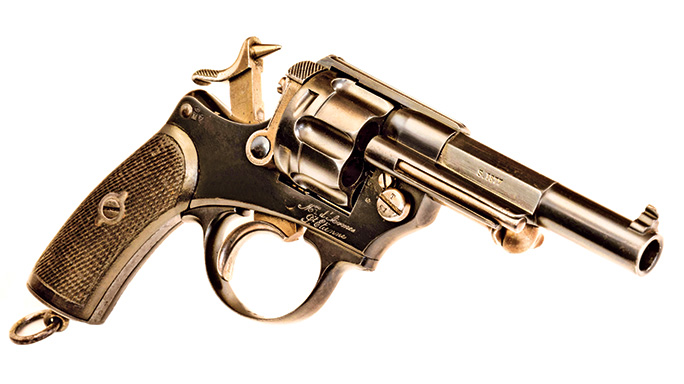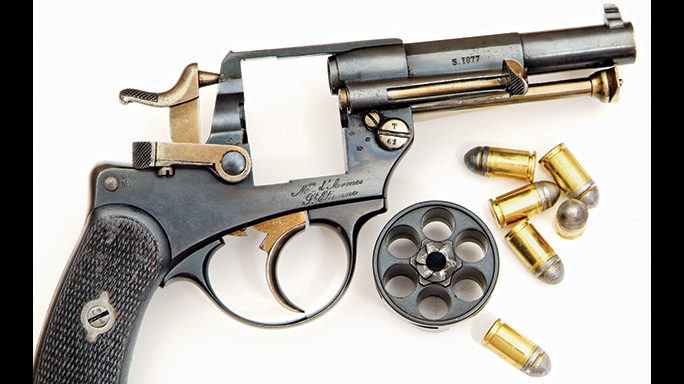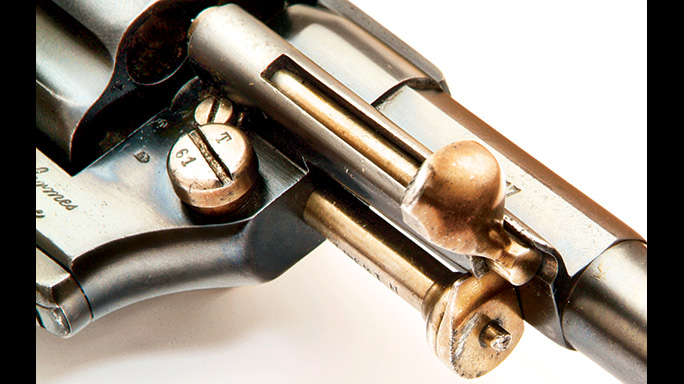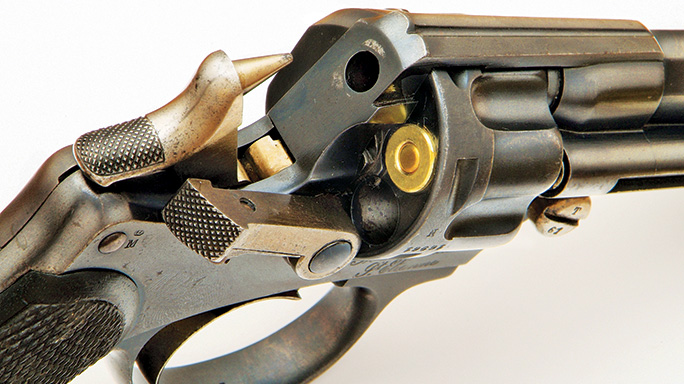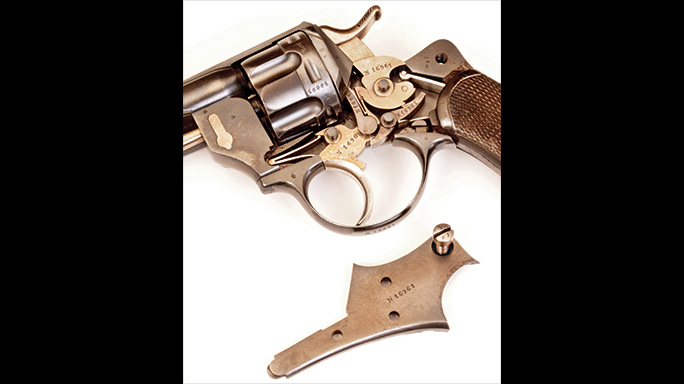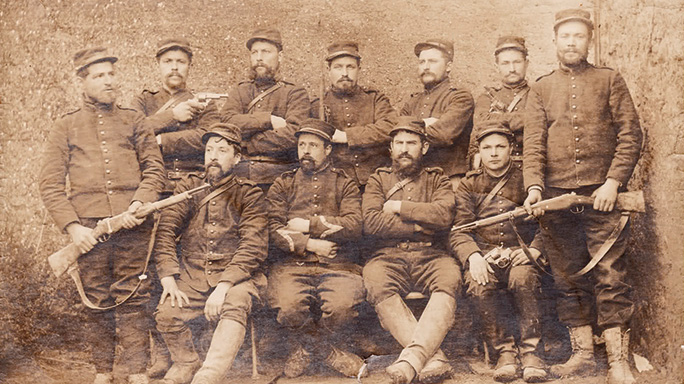In the 1870s, America regarded itself as the world leader in the design and manufacturing of handguns. Colt and Smith & Wesson were revered by the U.S. military, which armed its troops with their revolvers, and Americans venturing forth during the Westward Expansion were armed with every type of Colt and S&W revolver available, old and new alike. But in truth, the French firearms industry was fully one step ahead of America at the time, and it would take until the turn of the century for Colt, S&W and other established U.S. arms manufacturers to firmly take the lead and hold onto it in the 20th century.
- RELATED STORY: 10 Reasons Why You Should Own a Revolver
Having said that and infuriated countless 19th century American arms enthusiasts, let me make this introduction clear: In 1835 Samuel Colt invented and patented the first successful revolver, and the rest of the world followed him. Thus, it is the story of those who followed that takes us to France in the 1870s and Manufacture d’Armes de Saint-Étienne, or MAS.
One Step Ahead
Advertisement — Continue Reading Below
Although the newly inspired cartridge-firing Colt Single Action Army, S&W American and Remington single-action revolvers introduced in the early 1870s were regarded as contemporary firearms in the United States, cartridge revolvers had been in use throughout Europe since the 1840s. And the self-contained metallic cartridge that had transformed American arms-making in the post-Civil War era was even older. Long before Samuel Colt secured U.S., French and British patents for his designs in 1835 and 1836, across the pond European arms-makers were not sitting on their hands—nor had they ever. When it comes to metallic cartridges (as opposed to loose powder and ball used in Colt’s patented revolvers and in subsequent American-made revolvers manufactured after the Colt patent expired in 1857), the first patented cartridge design dates back to 1812, when Swiss inventor
Jean Samuel Pauley designed a self-contained, self-primed, centerfire metallic cartridge. Four years earlier Pauley had applied for another patent, this covering the design for the first in-line rifle, which he improved upon in 1812 with the introduction of a breech-loading rifle. Bear in mind that this was almost half a century before the Civil War and the general introduction of breech-loading cartridge rifles to the Union and Confederate militaries.
The percussion cap was an English invention that Sam Colt adapted to suit his new six-shooters (actually five-shooters in the 1830s). The French were also quick to recognize the advantages and were pioneers in rifled military percussion long arms with the Delvigne (1828) and Thouvenin (1844) systems as well as perfecting the muzzle-loading rifled musket with Captain Claude Etienne Minie’s famous “Minie ball” projectile. The first successful self-contained metallic cartridge produced in quantity was also French—Casimir Lefaucheux’s pinfire cartridge (1836)—which was followed by Louis-Nicolas Flobert’s rimfire cartridge (1845). And we should be thankful for the latter. It was Flobert’s rimfire that inspired Daniel B. Wesson’s design and patent for the .22 Short in the U.S. (the oldest American metallic cartridge) and S&W’s development of its first .22-caliber pocket revolver in 1857, the seven-shot Model No. 1.
Advertisement — Continue Reading Below
Flobert’s inspiration, however, ran even deeper with Mr. Smith and Mr. Wesson. Back in 1854, and prior to their establishing S&W, Daniel B. Wesson and Horace Smith worked together on designing a “saloon pistol” based on Flobert’s single-shot rimfire cartridge gallery gun, only their design allowed multiple shots and the chambering of rounds using a ring lever (toggle link) action. Smith and Wesson’s design evolved into the Volcanic rimfire pistols and repeating rifles of the 1850s, and with help from Oliver Winchester and American inventor Benjamin Tyler Henry, the Volcanic became the Henry lever-action rifle in 1860. And we all know where that leads. However, when it comes to cartridge-firing handguns, the sheer number of Lefaucheux pinfire revolvers imported into the U.S. during the War Between the States by both the North and South, along with more than 1 million pinfire cartridges, clearly made the case for breech-loading revolvers by 1865. Interestingly, the French were ahead on that score as well. Back in 1854, the French Navy was the first military organization to issue a cartridge-firing revolver, the Lefaucheux Model 1854 pinfire.
During the course of the Civil War, the Union Army acquired nearly 12,000 Lefaucheux pinfire revolvers, which were purchased under direct contract from the Ordnance Department and delivered by Marcellus Hartley, a partner in New York City importer and retailer Schuler, Hartley & Graham. Though little by comparison, the Confederacy imported another 2,500 pinfire guns between 1861 and 1865. As a result of the war, by the late 1860s, there were thousands of pinfire models remaining in use across the U.S., along with other European, British and American (S&W) cartridge revolvers in the hands of soldiers and civilians. When the calendar rolled over into 1870, Sam Colt’s percussion pistols were all but obsolete, and by 1872, Colt and Remington, among other American arms-makers, were hastily turning out cartridge conversion models of their Civil War cap-and-ball revolvers.
French Warriors
Advertisement — Continue Reading Below
In 1873, the same year Colt brought out the legendary Single Action Army, MAS introduced its new 11mm double-action revolver. The Chamelot-Delvigne Model 1873 was a compact, rugged handgun with an un-fluted, six-round cylinder. The un-fluted design was unique for two reasons: first, the rear section was of a larger diameter than the front so as to permit the location of the bolt stops without weakening the chamber walls (a problem Colt had suffered with the early 1860 Army models); secondly, the chambers had countersunk mouths to provide complete support for the cartridge heads, as there were no exposed rims at the back of the cylinder. The Model 1873 was left in the white, and this version was issued to French Army noncommissioned officers. A year later, the Model 1874 was introduced. This handsome, blued pistol had a contrasting white-steel hammer, ejector rod, loading gate and a distinctive fluted cylinder. The frame was also just slightly wider than the 1873. This version was issued to French Army officers.
If the Chamelot-Delvigne revolvers look familiar, there are at least two good reasons. A Model 1873 was carried by one of the outlaws who bushwhack Deputy Roscoe Brown (Barry Corbin) in the miniseries Lonesome Dove. That brief cinematic appearance might not have left an indelible impression of the Model 1873, although the bandit wore the gun around his neck on a lanyard, and that’s pretty unforgettable, but in the 2000 hit film The Mummy, star Brendan Fraser carried a pair of blued 1873s in a double shoulder holster, and those two revolvers got more screen time than some of the actors. Daniel Craig also carried a Chamelot-Delvigne revolver in the 2008 film Defiance, and the 1873 and 1874 have been used in more than a dozen movies (mostly period pictures) and a variety of American and British television miniseries. Like a Broomhandle Mauser, it is one of those distinctive handguns you can’t fail to notice.
As to their names, both the Models 1873 and 1874 used a variant of the Chamelot-Delvigne lock mechanism developed in Belgium in 1871. The lock mechanism and the guns themselves were so overbuilt that they were almost indestructible.
Advertisement — Continue Reading Below
MAS-TERFUL 11mm
Although the French Navy already had a centerfire Lefaucheux revolver by 1870, the Army wanted to stage its own trials, and the Small Arms Committee at Vicennes was given the task of finding a suitable weapon. Revolvers submitted included the Model 1870 Naval Lefaucheux, the Galand Model 1872, one from the arsenal at Puteaux, and another designed by a French officer named Auguste Henri Delvigne. Inter-service rivalries doomed the Navy’s Lefaucheux to quick rejection, while the Galand and Puteaux designs were deemed too complex. Thus Delvigne’s revolver was chosen as the basis for the Army’s new sidearm.
Delvigne had designed the gun in cooperation with a Belgian gunsmith by the name of Chamelot. Appropriately known as the “Chamelot-Delvigne system,” it featured a simple and robust selective double/single-action trigger mechanism that employed a hooked lifter for self-cocking and, since the cylinder hand was attached to the trigger, the hook engaged a bend in the hammer breast to permit single-action fire. When fired in double action, a long sear engaged a notch in the breast of the hammer and rotated it to the rear. A rebound spring safety was used to prevent the hammer from moving forward far enough to fire a cartridge unless the trigger was pulled through its complete stroke. This system reportedly gave the Chamelot-Delvigne a DA trigger pull superior to most of its contemporaries.
Advertisement — Continue Reading Below
At the same time in America, between 1873 and 1875, every arms-maker had new single-action cartridge models available, but in comparison to the double-action MAS Chamelot-Delvigne, they were all “technically” obsolete the day they were introduced! I say “technically” because, in point of fact, the MAS revolver could not be handled as easily as a Colt single action, nor was it as quick as Colt’s new 1877 and 1878 double-action revolvers, but the Colt double-actions were delicate guns that were prone to malfunctioning if not meticulously cared for, whereas the MAS Chamelot-Delvigne was built like an anvil. Every major component was oversized, particularly the hammer spur and loading gate. Rather than opening to the side, as was convention for loading gates in America, the MAS gate pulled straight back 90 degrees, clearing the way for easy loading and ejecting of spent cartridge cases. The ejector locked into place at the front of the cylinder arbor and was manually operated, with no spring to push the rod forward after kicking a case from the cylinder. While this minor inconvenience might have added a few additional seconds to the reloading process, clearance was such at the breech that reloading was quickly accomplished. The revolvers utilized a solid frame that had one truly notable feature: The left-hand sideplate could be removed for cleaning or repairs by simply unfastening one screw! Removing the cylinder and side panel was the only field-stripping required and either could be accomplished in one step.
The MAS Model 1873 Chamelot-Delvigne was issued with a standard 4.5-inch barrel and weighed approximately 35 ounces empty. Its grips were in the typical European saw-handle style with course checkering. One of the characteristic features of the French revolver that may have contributed to its use in colder climates was an oversized triggerguard ideal for winter weather, where heavy gloves were usually mandatory wear when venturing out. This would have been a distinct advantage, particularly so in the Northwest and during the Klondike gold rush (1896-1899) where used guns and cartridges could have come through Canada and into the hands of Americans seeking their fortunes in the wilds of Alaska.
Anemic Calibers
Advertisement — Continue Reading Below
One of the few disconcerting features of earlier European cartridge guns, as well as the first American cartridge guns built by Smith & Wesson, was the caliber. The S&W models were limited to .22 and .32 rimfire. Early European revolvers averaged around 9mm—roughly the equivalent of a .38—but the MAS revolvers chambered six 11mm cartridges. Oddly, in 1887 the French military decided to replace the hefty 11mm models with a lighter, smaller-caliber 8mm revolver. The loss of the military market and more than a decade of production may have prompted exports of the 11mm MAS revolvers—some to the U.S., where the standard was the big .45 Colt, a cartridge very close in diameter to the 11mm French rounds. To be exact, an 11mm cartridge is between a .44 and a .45 in approximate case diameter, and it’s slightly shorter than the .44 Russian. With a shorter case and subsequently less powder, the 11mm didn’t pack quite the wallop of a .45 Colt, but it was more than adequate to get the job done at close range with a 179-grain, .446 heeled-lead bullet. Original cartridges were loaded with 10 grains of black powder and developed a most unimpressive velocity of 430 fps.
The Models 1873 and 1874 were produced by MAS from 1873 to 1887, with about 337,000 copies of the 1873 and 35,000 of the 1874. Although replaced by the Model 1892 revolver, the 1873 and 1874 were still widely used during World War I, and issued again to reserve units in 1940. The French Resistance also made widespread use of the MAS 1873 and 1874 revolvers during the German occupation, giving these 19th century handguns a remarkably long period of military and combat use.
Field Test
Advertisement — Continue Reading Below
During my field test, using 11mm cartridges specially created by Bernie Rowles of Old West Bullet Moulds in Fruita, Colorado, a Lyman electronic trigger pull gauge indicated that 8.12 pounds tripped my Model 1874’s cocked hammer, and 13.5 pounds was required when fired double action. With the MAS 1874 in hand and 100 rounds of Bernie Rowels’ 11mm cartridges, I headed to the test range to see if this front-heavy French sixgun truly earned its place in the history books. Pacing off 50 feet from the target and firing off-hand, the 11mm rounds went downrange at around 550 fps, placing the majority of shots within a 2.5-inch circumference. Rowles’ handloaded 11mm rounds had only modest recoil with a light 14-grain charge of American Pioneer. They were, however, remarkably consistent.
- RELATED STORY: Top 8 Revolvers From COMBAT HANDGUNS
In the late 1800s, especially in the Northwest, if one had come across this well-built French revolver and a supply of 11mm ammunition, it no doubt would have served its owner well. Considering the condition of this example, it saw very little use during its life, a life no doubt spent in the holster of someone fortunate enough to have owned one of the finest double-action revolvers of its day.
The author would like to extend his thanks to author Paul Scarlata who contributed significant historical information and archival photos to this article.
Advertisement — Continue Reading Below
